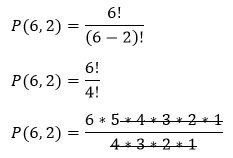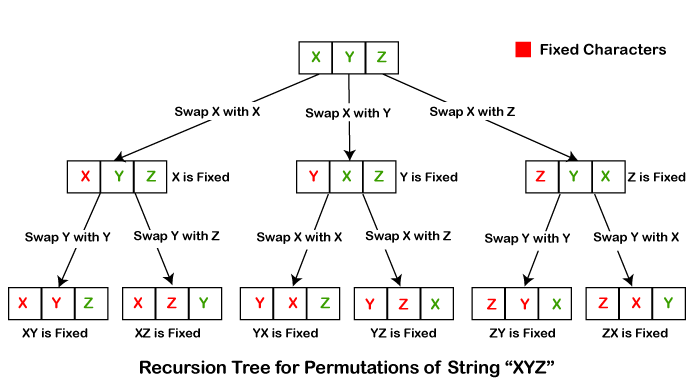Permutation of Numbers in JavaIn this section, we will create a Java program and find the permutation and cyclic permutation of a number. Before moving ahead in this section, first, we will understand permutation with examples. PermutationIn mathematics, the permutation is a method or technique in which we can determine the possible arrangements in a set. The number of ways of selection and arrangement of items in which orders matters. In short, the permutation is the number of arrangements. While determining the permutation, keep order in mind. It is denoted by the letter P. In other words, it is a technique by which we can arrange (or select) r objects out of given n objects in a particular order. Mathematically, we can find the permutation of the numbers by using the following formula: 
Where, P: P is the number of permutations. n: n is the total number of objects in the set. r: r is the number of choosing objects from the set. !: The symbol denotes the factorial. For example, if XYZ is a word then the possible permutations of the word will be:
XYZ, XZY, YXZ, YZX, ZXY, ZYX
Hence, we can arrange the word XYZ in six distinct ways. Let's see an example. Example: There are six people participating in a skit. In how many ways first and the second prize can be awarded? Solution: Given: n=6, r=2, P=? According to the above formula: 
4, 3, 2, 1 are presented in both nominator and denominator so, they are canceled out. P(6,2)=6*5 P(6,2)=30 Hence, there are 30 possible ways to award the first and second prizes. Let's implement the above approach in a Java program. PermutationExample1.java Output: Enter the Value of n and r: 7 4 The permutation of P(n, r) = 840 Let's create another Java program and find the permutation of a number n greater than the number itself. PermutationExample2.java Output: 132 213 231 312 321 Using Heap AlgorithmIt is an iterative algorithm. By using the heap algorithm, we can find all the permutations of n objects.
Let's implement the algorithm in a Java program. PermutationExample3.java Output: 8 2 6 7 2 8 6 7 6 8 2 7 8 6 2 7 2 6 8 7 6 2 8 7 7 2 6 8 2 7 6 8 6 7 2 8 7 6 2 8 2 6 7 8 6 2 7 8 7 8 6 2 8 7 6 2 6 7 8 2 7 6 8 2 8 6 7 2 6 8 7 2 7 8 2 6 8 7 2 6 2 7 8 6 7 2 8 6 8 2 7 6 2 8 7 6 Using Recursive AlgorithmThe recursive algorithm uses backtracking. It demines the permutation of numbers by swapping one element per iteration. 
Let's implement the algorithm in a Java program. PermutationExample4.java Output: come coem cmoe cmeo cemo ceom ocme ocem omce omec oemc oecm moce moec mcoe mceo meco meoc eomc eocm emoc emco ecmo ecom Randomized AlgorithmWe can also apply the randomized algorithm for determining the permutation of numbers. It is used if the value of n is big. The algorithm generates the permutations by shuffling the array. For shuffling, the Java Collections class provides the shuffle() method. The shuffle() method randomly permutates the specified List using a default source of randomness. It traverses the list in a backward (from the last element to the second element) direction. It randomly swaps the selected element with the current position. The method runs in linear time. The signature of the method is: Generating Cyclic PermutationsA permutation composed of a single cycle is known as the cyclic permutation. It shifts all the elements of a set by a fixed offset. The technique can be applied to any integer to shift cyclically right or left by any given number of places. If a set has elements {a, b, c}, then:
Suppose n is a number whose cyclic permutation is to be found. We can find the cyclic permutation by using the following steps. It generates the next permutation. We execute the above steps until we get the original number. As soon as, we get the original number, we stop performing the above steps and return the remainder. For example, find the division of the following fractions: 2/7 = 0.285714... 4/7 = 0.571428... 1/7 = 0.142857... Let's create a Java program and generate all the possible cyclic permutations. PermutationExample5.java Output: 9871 1987 7198 8719
Next TopicMagic Number in Java
|
 For Videos Join Our Youtube Channel: Join Now
For Videos Join Our Youtube Channel: Join Now
Feedback
- Send your Feedback to [email protected]
Help Others, Please Share










